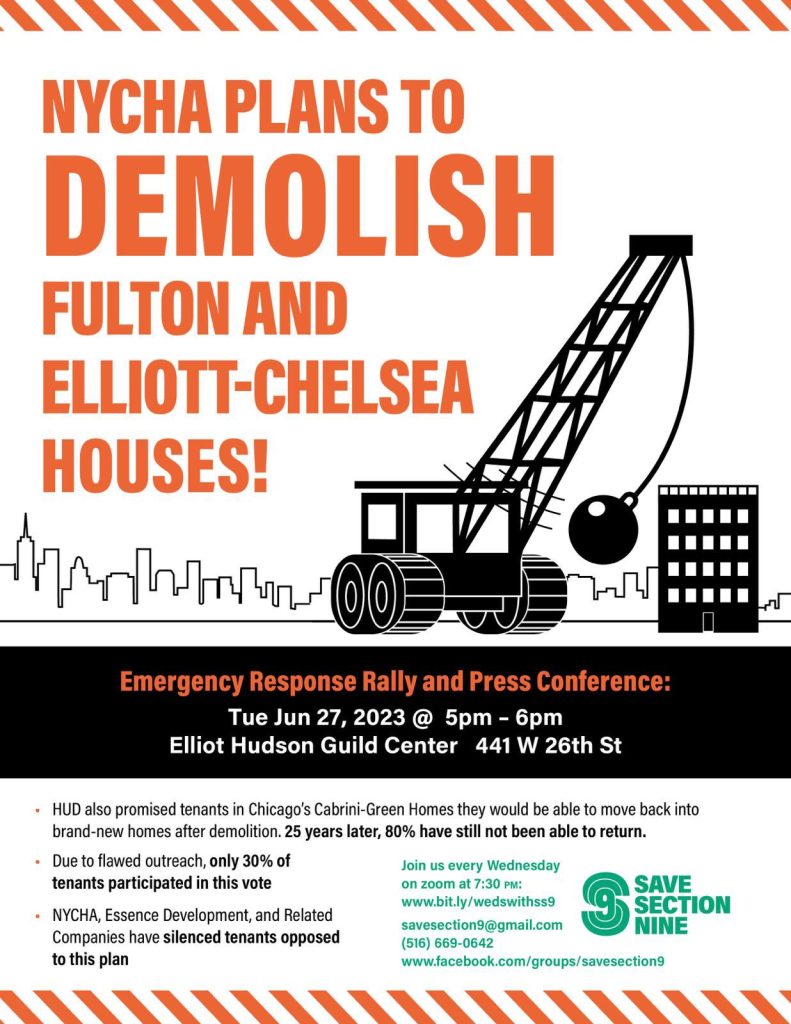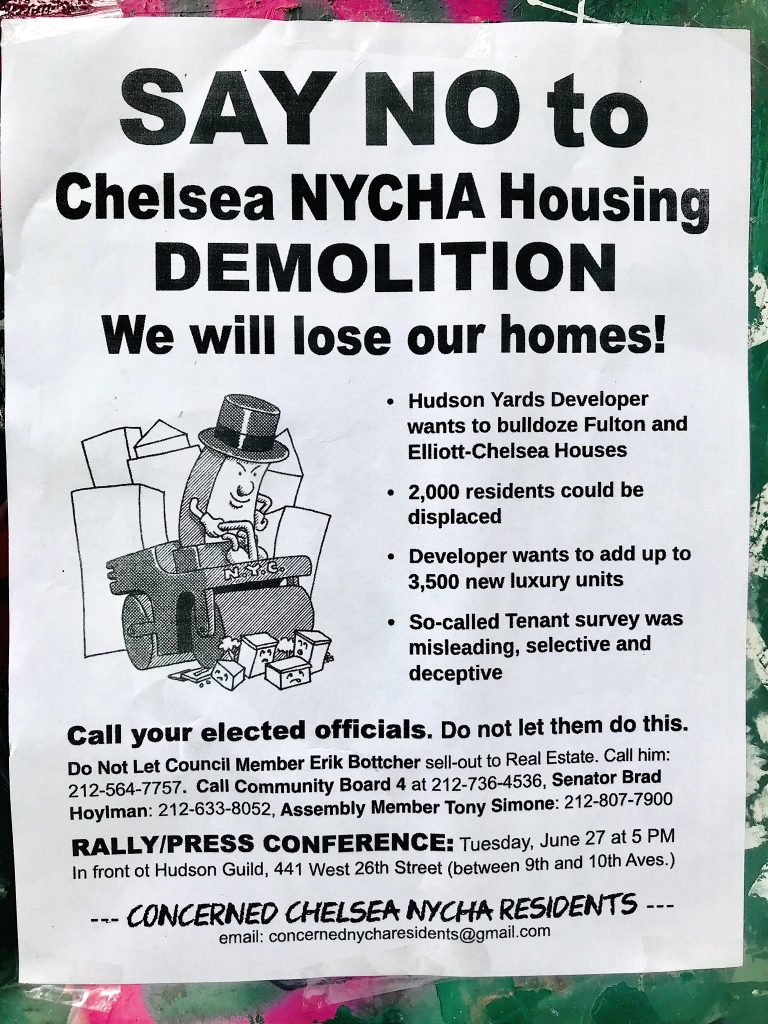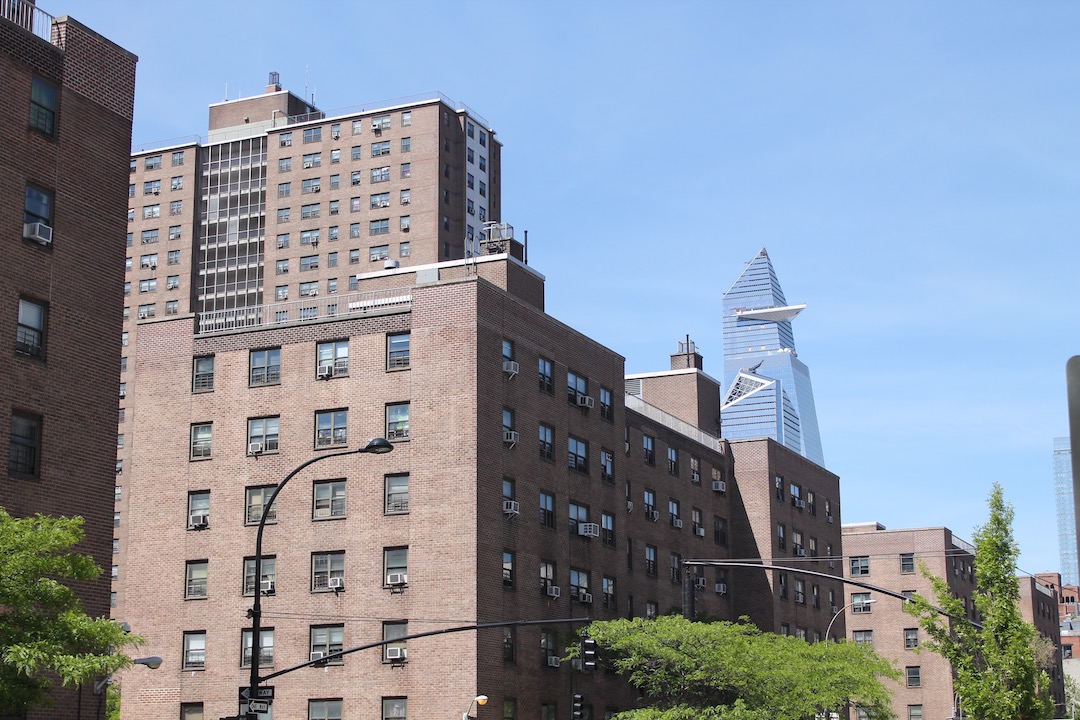BY THE VILLAGE SUN | Updated July 15, 1:45 p.m.: In an unprecedented move for New York City public housing, a developer has won the O.K. for a sweeping scheme to completely rebuild two entire Housing Authority complexes in Chelsea.
In late June, the Related Companies and tenant association leaders announced the plan, which would raze and rebuild the Robert Fulton and Elliott-Chelsea Houses in the heart of the prime Manhattan real estate area.
Previously, as part of a new public-private initiative to run the complexes, the city had agreed that none of the buildings would be demolished, though the developer would take over the properties’ management and be responsible for their renovation.
But, according to Related — the main developer of the glitzy Hudson Yards — it was ultimately determined it would be less costly simply to rebuild the aging buildings anew than to renovate them.
Prior to the abrupt change of direction, however, there had been several years of engagement with residents about the complexes’ future path, beginning with the Chelsea Working Group in 2019 and then continuing with the Resident Review Committee. Then, this year, the option of the total rebuild emerged.
According to Related, “A resident survey confirmed that more than half of all respondents wish to pursue total redevelopment over rehabilitation of current buildings.”
Related is partnering with Essence Development on the massive project. Under the scheme, the rebuilt New York City Housing Authority buildings would be project-based Section 8 buildings, as opposed to their current program, Section 9.
The new plan, which would be overseen by NYCHA and Essence Development, and co-developed by Related Companies, would also include constructing additional mixed-income buildings and community facilities. A zoning change would permit the new buildings to be taller than currently allowed. In all, 17 buildings would be demolished and replaced by eight buildings — not including the mixed-income ones.
Nearly 4,500 residents currently live in 2,055 apartments in the Fulton and Elliott-Chelsea Houses. Under the plan, residents’ new units would feature “enhanced layouts, ventilation and energy efficiency,” according to Related. To allow the project to go forward, current tenants would be moved to other NYCHA buildings in a “phased relocation,” then return afterward.
Of the roughly 3,500 new mixed-income apartments to be added into the mix of the two NYCHA campuses, about 875 would be affordable — though critics question how affordable they really will be.
It’s expected construction would take six years. The original plan only to renovate the existing buildings would take four years.
According to Related, this year, during a 60-day period beginning in March, Essence and NYCHA held 35 information sessions, canvassed thousands of residents and mailed informational packets to every apartment in the developments to inform the community of the process and the three options up for consideration. Residents age 18 and older could indicate their preference for new buildings or rehabbing the existing ones either online or in a paper survey. If residents selected new buildings, they could then choose from two different construction plans.
However, critics of the plan said only around 1,000 people — or less than one-quarter of the tenants — actually participated in the survey.


Meanwhile, the mayor, local politicians and HUD all joined tenant association leaders in trumpeting the NYCHA plan.
“Our administration has always put residents front and center in decision-making, and I am excited that the residents of Fulton and Elliott-Chelsea Houses have seized their opportunity to plan their own future,” Mayor Adams said. “No one knows better than the residents what they and their neighbors need, and they were smart to recognize the potential benefits of completely rebuilding their campus.”
“We are grateful to the hundreds of Fulton and Elliott-Chelsea residents that participated in this first-of-its-kind selection process, helping to bring NYCHA and our city’s public housing to the next generation,” said tenant association presidents Miguel Acevedo and Darlene Waters. “When residents lead and have a seat at the decision-making table, we can find solutions that prioritize our safety and better our surrounding neighborhoods.”
“We look forward to continuing to work with residents, our elected officials and the entire community to deliver on the promise that was made to Fulton and Elliott-Chelsea tenants to finally give them the homes they deserve,” said Bruce Beal, Related Companies president.
“This transformation will serve as an example for future NYCHA redevelopment,” said Alicka Ampry-Samuel, Housing and Urban Development regional administrator for New York and New Jersey.
Also hailing the scheme were Congressmember Jerrold Nadler, state Senator Brad Hoylman-Sigal, Assemblymember Tony Simone and Manhattan Borough President Mark Levine.
“This plan puts the needs and priorities of the residents front and center, and I am pleased that the relevant parties — most notably the residents themselves — have come together to move forward with a complete rebuilding of the Fulton and Elliot-Chelsea Houses,” Nadler said. “With the current buildings in disrepair as New York faces a housing crisis, these new apartments will provide modern, comfortable housing for all existing residents while adding approximately 3,500 new units to the campuses.”
“With more than half of the tenants having voted in support of the plan, it’s clear that these NYCHA tenants want and deserve better housing for themselves and their neighbors,” Hoylman-Sigal said.
“Over the past few months, my team and I have been regularly on the ground to ensure any plans for the future of NYCHA campuses in Chelsea are informed and chosen by the residents who deserve to live in dignity,” Simone said. “As this process now moves to the next stage, I will continue to ensure that the future of NYCHA homes is in the hands of no one but NYCHA residents. Our neighbors here have lived in deteriorating and dangerous conditions for far too long, and the time for delays and excuses is long past.”
“The physical conditions of the buildings in Fulton and Elliot-Chelsea have degraded over decades of neglect and are now absolutely unacceptable,” said Manhattan Borough President Mark Levine, praising the “modern and energy-efficient homes and vibrant community spaces” the new plan would provide.
The Hudson Guild — which is based in the Elliott-Chelsea Houses and offers community programming — is also firmly behind the first-of-its-kind rebuild megaproject.
“Hudson Guild stands with our neighbors in NYCHA as they have voted to rebuild the Fulton and Elliott-Chelsea complexes,” said Ken Jockers, the organization’s executive director. “The Guild is committed to supporting a plan that results in decent, dignified apartments for all with, at minimum, the same protections and rights that Elliott-Chelsea and Fulton residents have today.”
Meanwhile, local activist Marni Halasa, who ran for City Council District 3 in 2017 and 2021, has been standing with NYCHA tenants who oppose the project. There have been two organized protests so far, including at a June 27 “engagement meeting” at Hudson Guild where 70 tenants showed up and declared they are against demolition, and on July 12 at Stuyvesant High School at a NYCHA budget meeting.
“This plan is called a RAD blend — it’s privatization as well as demolition — and it’s so [messed] up,” Halasa said, referring to the Rental Assistance Demonstration program. “They want to demolish 17 buildings, which is all of Fulton and Elliott-Chelsea public housing. Then they are claiming they are going to move basically 5,000 people into eight buildings, and they are guaranteeing that every single person will be housed, which history shows is not the case. Ten years ago there was a NYCHA development in Brooklyn called Prospect Plaza. They moved all 1,200 tenants out of the building, claiming to renovate. Tenants waited for seven years for renovated apartments and they demolished those buildings and replaced them with condos. Cabrini Green in Chicago was another example. They demolished that public housing and 80 percent of the residents never returned, and again it was replaced with condos. That’s the model of what really happens.”
In addition, tenants against the plan claim they are hearing NYCHA’s own representatives say the tenants will not be moved back into newly constructed apartments at the Chelsea locations but to other developments in the outer boroughs.
The opponents further note that Fulton Houses residents already spoke out against privatization and demolition. In 2019, 60 percent of Fulton tenants signed petitions stating they were against any privatization and demolition of their complex.
“We are not naive,” said George Weaver, a Fulton Houses tenant. “It’s quite clear that the developers want to annex public housing for luxury development and displace long-term residents who are seniors, disabled and low- and middle-income workers who are predominantly people of color. That’s a recipe for displacement, homelessness and death, and must be stopped. We need the support of everyone,” he stressed, “including our elected officials who would like to stay in office.”


The very fundamental issue here has always been economics first. This RAD initiative is allegedly a response to NYCHA’s inability to secure and provide adequate, sustainable funding to effectively maintain and manage its housing portfolio, consequently proposing the eradication of Section 9, the original Public Housing concept. This poses legitimate concerns regarding the sustainable quality of life for the Resident Population not only in Chelsea/Elliott but across the entire NYCHA dynamic. Given this justifiable concern, it is imperative for collective efforts in seeking economic alternatives that embrace expressed Resident Priorities predominantly!! Additionally it is also incumbent for Resident Leadership to research and propose viable, sustainable economic alternatives as it is their Quality of Life that’s at stake. IJS.
Literally said they weren’t going to demolish, and now it will be demolished.
8 known structures are in the plans while plans to demolish 17 sounds like an excuse to contribute to the homeless population.
Damn, is the Village Sun always this evil?
Sorry, we only reported the news about the plan, we did not create the plan or endorse it. Blame NYCHA.
Related nor Essence never mailed any pamphlets or any other documents to the residents. Their idea of reaching out to the tenants was by leaving notices or pamphlets on our doorknobs. There is a lot of misinformation that comes from the Related team, including NYCHA.
You are absolutely right regarding NYCHA. They are to blame for what’s going on. They have been caught in fraudulent practices. More of them need to get exposed. Especially those in the higher chain of command.
It is hard to imagine that there are actually vacant NYCHA apartments for construction-relocation? Also the units would need to be relatively close – not OK to relocate an elderly person to the Rockaways or Staten Island.
Related issues: There are homeless New Yorkers in shelter system seeking permanent housing, including NYCHA.
And the City also housing huge number of “asylum” seekers in tourist hotels.
According to the plan, 94% of residents in the NYCHA buildings will stay in their apartments until the new buildings are ready for occupancy. So only 6% will need to be relocated – even that, as you say, could be a challenge.
There is some serious funny business going on here.
As I recall from other previous reporting, the residence survey was supported by roughly 60% of the respondents. But only about 30% of the eligible respondents participated.
First, it would be quite interesting to see how the survey question was phrased, and what residents were promised.
Second, 0.6 x 0.3 = 0.18, which means the survey question was supported by less than 20% of residents.
Anyone who would consider that a consensus, let alone a majority, has some explaining to do.
Where are they going to house the 5000 tenants while the new buildings are being built?
“phased relocation” to other NYCHA buildings.
Related has a history (i.e., West Village Houses, 420 units) of proposing notional relocation sites.
It’s like the stranded castaway, who happens to be an economist, when a can of soup washes up on the beach of his otherwise deserted island.
“I’ll just assume I have a can opener.”